Our Promise
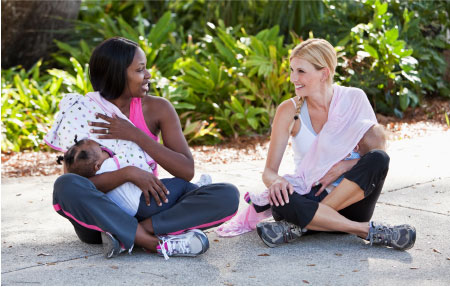
The Windsor-Essex County Health Unit (WECHU) offers non-judgmental and confidential services to all families.
We appreciate and value the diversity of all individuals and do not discriminate based on age, race, religion, ability, marital status, sexual orientation, sex, or gender identity.
At WECHU, we provide feeding support to all families those who are breastfeeding, body feeding, chest feeding, bottle-feeding expressed breast milk, bottle feeding formula or doing combination feeding.
Our goal is to help you and your family make an informed decisions about
how to feed your baby.
How you feed your baby is the first important decision you will make as a parent. Breastfeeding is beneficial to you and your baby. Breastfeeding:
- Can reduce your risk for diabetes and certain cancers.
- Supports your baby’s gastrointestinal health and oral development.
- Can reduce the frequency of childhood infections.
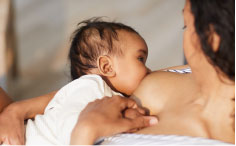
How long does it take to figure out breastfeeding?
It can take anywhere from a few days to 6 weeks for breastfeeding to become well-established, but it’s worth it! Breastfeeding provides so many opportunities for you to bond with your baby. Once you and your baby figure out breastfeeding, it’s easy and convenient. Plus, it can save you a lot of money.
During the first few weeks of your baby’s life, be extra patient with yourself. You and your baby are both learning the skills needed to breastfeed well. Don’t be afraid to ask family and friends for help with household tasks (e.g., laundry, dishes, meals). That way, you will have the time needed to rest and be able to recognize and respond to your baby’s early hunger cues (see page 8).
It’s also important to ask professionals for help, if needed. If you experience pain or other challenges when learning how to breastfeed, seek help right away. See the “Where to get help” page at the beginning of this resource for more information.
Can I give pacifiers (soothers), bottles, or formula to my breastfed baby?
Pacifiers and bottles can cause nipple confusion. Wait until breastfeeding is going well before introducing pacifiers (soothers) and bottles.
Formula can affect your baby’s gut health. If your baby needs supplementation; use your own expressed breast milk. If that is not an option, formula is okay. A fed baby is best!
Newborn babies need to be at the breast at least 8 times a day. This stimulates your breastfeeding hormones, telling your body to make milk. For any missed breastfeeding sessions, be certain to hand express or pump, so your milk supply does not decrease.
Your bare chest is the best place for your baby to adjust to life outside the womb.
Immediately after birth hold your baby belly-down on your chest or tummy. The first hours of snuggling skin-to-skin help you and your baby bond and get to know each other. Keep cuddling skin-to-skin as often as possible in the months after birth. The benefits for bonding and breastfeeding continue long after that. Skin-to-skin is also better for babies born prematurely or by Caesarean birth.
Benefits for babies
- breastfeed better
- cry less and are calmer
- stay warmer
- enjoy more comfort from you
- have better blood sugar levels
- are protected by some of your good bacteria
Benefits for mothers
- breastfeed more easily
- learn when your baby is getting hungry
- bond more with your baby
- gain confidence and satisfaction caring for your baby
Benefits for breastfeeding
- your baby is more likely to have a successful first breastfeed
- your baby may breastfeed sooner and longer
- you will make more breast milk
- helps your baby breastfeed when sleepy
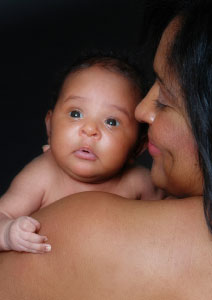
Skin-to-skin is easy. Here’s how:
- Take off your baby’s blankets and clothing. Leave a diaper on.
- Move your clothing away from your chest and tummy.
- Hold your baby, facing you, against your chest or tummy.
- You can put a blanket over you and your baby.
- Enjoy the closeness and bonding with your baby.
Note: Babies under 6 months old should be placed on their back in a crib or cradle close to your bed when you are ready to sleep. It is important that cribs and cradles meet current Canadian safety regulations.
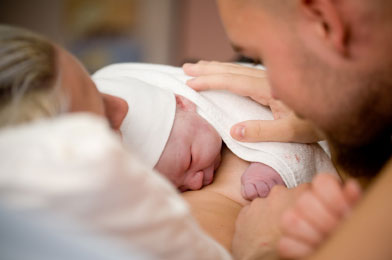
Family and skin-to-skin
Your family members can also spend skin-to-skin time with your baby. If you have a partner, plan skin-to-skin time together with your baby. It’s a great way for you and your partner to spend time together and bond with your baby.
As your baby grows continue to hold your baby skin-to-skin.
Breastfeed your baby immediately after birth. Your baby is awake and ready to learn how to breastfeed during this time. Breastfeeding early will help you to make more breast milk.
In the first few days you will produce breast milk (colostrum) that is:
- thick like honey
- yellow in colour
- high in calories
- small in amount (but all your baby needs)
As you continue to breastfeed over the next few days, your breast milk will:
- become more white in colour
- increase in amount
- meet all your baby’s nutritional needs
Having your baby breastfeed well and often in the first week will help you to build a healthy breast milk supply.

Signs of hunger
Babies will let you know when they are hungry; the following are signs that your baby is hungry and
needs to breastfeed. Your baby:
- makes sucking or soft sounds
- puts her hands in her mouth
- is making more body movements
- makes sucking or licking movements with her mouth
Breastfeed your baby when your baby is calm and before your baby is too hungry and crying.
Do not give your baby pacifiers or bottles. Babies need to learn how to suck at the breast. If you make an informed decision to use pacifiers or bottles it is best to wait until breastfeeding is well established, usually around 4-6 weeks.
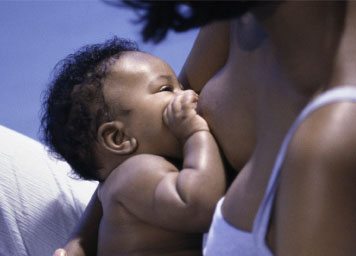
Vitamin D
Health Canada recommends giving all breastfed babies a daily Vitamin D supplement (10 ug or 400 IU).
Baby-led latching is a natural and simple way for your baby to find your breast.
Baby-led latching
Baby-led latching can be encouraged after your baby is born. It is also helpful when your:
- baby is learning to breastfeed
- baby is not breastfeeding well
- nipples are sore
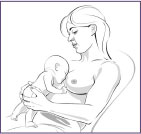
- start when your baby is calm
- sit comfortably and lean back a little
- hold your baby skin to skin (tummy to tummy) on your upper chest and between your breasts
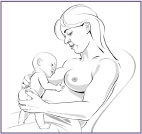
- your baby will start moving her head up and down looking for your breast (this may look like bobbing or pecking)
- support your baby’s neck, shoulders, and bottom with your arm and hand while she moves towards your breast
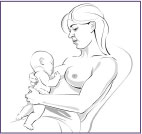
- your baby will:
- move towards your breast
- find your nipple
- push her chin into your breast
- reach up with an open mouth
- latch onto your breast
- it may help to bring your baby’s bottom close to your body and/or give support to your baby’s back and shoulders
- once your baby is latched, you and your baby can find a comfortable position
Try different breastfeeding positions. Choose a breastfeeding position that allows you to be relaxed and comfortable. With all positions make sure your back and arms are well supported.
Breastfeeding positions
There are many different positions for breastfeeding. Here are some breastfeeding positions that may work for you and your baby.
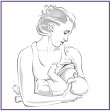
Cross cradle
This position works well if you:
- are learning to breastfeed
- have a small baby
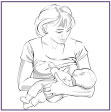
Cradle position
This position works well:
- after you are comfortable with breastfeeding

Football position
This position works well if you:
- are learning to breastfeed
- have difficulty maintaining a latch
- have a small baby
- have large breasts
- have flat or sore nipples
- had a Caesarean birth
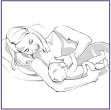
Side-lying position
This position works well if you:
- find it too painful to sit
- want to rest when you breastfeed
- have large breasts
- had a Caesarean section
Having a good latch will help you make enough breast milk and help your baby to breastfeed well. It will also help prevent pain when breastfeeding.
Latching your baby

Get comfortable and find a position that works well for you.
Make sure that you are comfortable with your back and arms well supported and your baby’s tummy is facing you (place your baby on her side except in the football position – for the football position, place your baby on her back or slightly turned to your breast).

Hold your breast in your hand. Thumb is on top and fingers are below your breast.

Face your baby’s nose to your nipple. Stroke your baby’s lower lip with your nipple. Wait until baby’s mouth is wide open like a yawn.

Bring your baby, chin first to your breast. Her mouth should cover lots of the dark area below the nipple (about 11/2 inches).
Your baby is latched properly on the breast when:
- her mouth is opened wide
- her lips are curled out
- her chin is pressed into your breast
- she is sucking and swallowing breast milk

If your baby falls asleep while breastfeeding, squeeze your breast to help the breast milk flow. Do not squeeze so hard that it hurts. This will help
your baby to start sucking again.

Also try taking your baby’s clothes off or changing her diaper.
Gently massage your baby’s back, feet, or hands.

If you want to take your baby off your breast, break the suction by:
- slipping your finger into the corner of your baby’s mouth, OR;
- pulling down on your baby’s chin.
Offer the second breast when your baby no longer has strong “deep and slow” sucks and your breasts feel softer. Your baby may only breastfeed a short time on the second breast. At the next breastfeeding offer the breast that feels the fullest.
Your baby is breastfeeding well when…
You feel:
- your breast being pulled with no pain
You hear:
- your baby swallowing (a quiet, exhaled “kaa kaa kaa”)
You see:
- a wide open mouth
- curled out lips
- chin pressed into your breasts
- sucking and swallowing (quick and shallow at the beginning and deep and slow as the breast milk starts to flow)
At the start of the breastfeed your baby will have shallow and quick sucks. When your breast milk starts to flow, the sucks should become deep and slow. There should be a pause during the sucking when your baby’s mouth opens widest. Your baby is drinking breast milk during this pause.
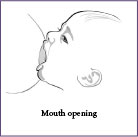
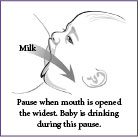
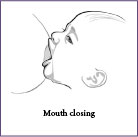
Wet diapers and stools
| Baby’s age | Wet diapers each day * At all ages urine should be clear to pale yellow with almost no smell |
Stools each day |
| 1 day old |
|
|
| 2 days old |
|
|
| 3 days old |
|
|
| 4 days old |
|
|
| 5-6 days old and older |
|
Baby should not be passing any |
| 6 weeks to 6 months |
|
After 6 weeks some breastfed babies may only have 1 very large yellow stool every 1-7 days. This is normal as long as the stool is soft like toothpaste, or seedy, and watery, and your baby is healthy. It is also normal for some breastfed babies to have many stools each day. |
Weight gain
Breastfed babies:
- may lose 7% or less of their birth weight in the first 3 days after birth
- should return to their birth weight by 10 days of age
- should show a pattern of weight gain by day 5
- should gain at least 20-35 grams (2⁄3-11/4 oz) a day in the first 3-4 months of age
Growth spurts
Growth spurts are the times your baby grows more quickly and will need more breast milk. These spurts occur frequently in the first few months. During these times breastfeed more often when your baby seems hungry. There are no set times to breastfeed your baby. Most babies will breastfeed at least 8 times in 24 hours (day and night). Your breast milk supply will increase.
Other signs that your baby is breastfeeding well:
- baby has a loud cry
- baby’s mouth is wet and pink
- baby’s eyes look alert
- baby moves actively
- baby comes off the breast looking relaxed and sleepy
- breasts feel softer and less full after breastfeeding
Get help right away if your baby is not showing signs of breastfeeding well.

Breastfeeding is a learned skill for mothers and babies. It requires patience and practice. Don’t hesitate to ask for help.
General breast care
- Rinse your breasts with water only and air dry. Do not use soap on your nipples. Soap may dry your nipples and cause them to crack.
- Wear a bra that fits well and is not too tight. Do not wear a bra with underwire.
- After breastfeeding express some breast milk onto your nipples and the dark area around them to help protect the skin. Let the breast milk dry before putting on your bra.
Caring for breasts that are hard
Apply cold or warmth to your breast, use whichever feels best.

How to apply cold
You can put a cold compress on your breast for a few minutes. This can help to decrease swelling.
Cold compresses can be a:
- gel pack wrapped in a cloth
- bag of frozen peas
- frozen wet towel

How to apply warmth
You can put warmth on your breast by:
- having a warm shower until breast milk starts to flow
- placing a warm towel on your breast for a few minutes until your breast milk start to flow
Warmth may also be applied to your breast by using a:
- warm wet disposable diaper
- heating pad on low
- hot water bottle wrapped in a cloth
Next gently massage your breasts and express some breast milk until the area around your nipple feels soft (see section on Expressing breast milk on page 17). Breastfeed your baby often until your breasts are no longer hard.
Get help right away if you:
- cannot soften breasts or are having problems breastfeeding
- have a red and painful area on your breast
- have a fever
- are feeling sick
Caring for sore/painful nipples
There may be some nipple tenderness in the first week after birth. This should get better each day.
Breastfeeding should not be painful when your baby is positioned and latched properly.
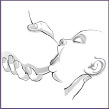
Check that your baby’s:
- mouth is opened wide
- lips are curled out
- chin is pressed into your breast and your baby is sucking and swallowing breast milk
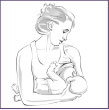
Check that your baby’s:
- head and body are raised up to your breast
- head is at the level of your breast
- chest is facing your tummy
- mouth is facing your nipple
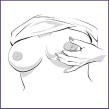
After breastfeeding:
- express some breast milk onto your nipple and the dark area around it (only if there is no nipple damage or thrush)
- let the breast milk dry before putting on your bra
If you want to take your baby off your breast break the suction by:
- slipping your finger into the corner of your baby’s mouth OR
- pulling down on your baby’s chin
Get help right away if your nipples are still painful after checking that your baby is latched and
positioned on the breast properly.
Most women are able to express breast milk by hand.
You may need to express breast milk if:
- your baby is having difficulty with latching
- your breasts are too hard for your baby to latch
- you want to give your baby breast milk when you are away from your baby
- you need to increase your breast milk supply
You can express your breast milk by hand or by using a breast pump. Hand expression takes time to learn but will become easier and faster as you practice. It involves no cost, is always available and can be done anytime, anywhere.
How to express breast milk by hand

Wash your hands with soap and water.

If your baby is healthy, use a “clean” glass or hard plastic (BPA free) container to collect your expressed breast milk. “Clean” means to wash in hot soapy water, rinse well with hot water and leave to air dry on a clean surface away from where food is made.

To help breast milk begin to drip, try any of the following:
- place a warm towel on your breast for a few minutes
- gently massage your breast towards the nipple
- gently roll your nipple between your thumb and finger

Place your thumb and first 2 fingers along the outer edge of the dark area (areola).

Push your thumb and 2 fingers straight back towards your chest.

Gently compress your breast using your thumb and fingers and roll fingers towards your nipple; then relax your fingers.
Repeat steps 4, 5 and 6 until the flow of breast milk slows down then switch to the other breast.
Tips for expressing breast milk
- Express in the morning, when your breasts feel fullest or after breastfeeding your baby.
- Be patient. You may only get a few drops of breast milk when first learning to express. Expressing breast milk will get better and easier with practice.
- Move your thumb and fingers in different positions around your nipple to ensure that all the breast milk ducts are emptied.
- Switch breasts whenever the flow of breast milk slows down.
- Most women are able to express breast milk by hand; however you can also express breast milk using a breast pump.
Storing expressed breast milk
Containers for storing breast milk
- Use glass or hard plastic (BPA free) containers with an air-tight lid (for example, small jars and bottles with lids).
- Special breast milk freezer bags can also be used.
- Do not use bottle liner bags. These are thinner plastic bags that may break when frozen.
Cleaning the containers
Wash containers in hot soapy water and rinse well with hot water. Let the containers air dry on a dry clean surface away from where food is made.
* If your baby is premature (born too early) or in the hospital, speak to your nurse about storing breast milk and cleaning containers. Sterilized containers may be provided by the hospital.
Breast milk can be stored in the following ways
Room Temperature: ≤ 25°C or 77°F for 6-8 hours
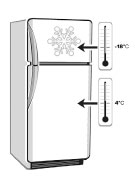
Freezer of a
2 door refrigerator
-18°C or 0°F
for 3-6 months
Refrigerator
≤ 4°C or 40°F
for 5 days

Deep Freezer
Chest or Upright
-20°C or -4°F
for 6-12 months
Important
- Place containers at the back of the refrigerator and freezer where it is the coldest.
- After the storage time has passed, throw out the breast milk.
Freshly expressed breast milk left at room temperature for more than 6-8 hours should be thrown out.
Storing Tips
- Refrigerate or chill freshly expressed breast milk within 1 hour of expressing if you are not going to feed it to your baby within 6-8 hours.
- Label containers with date and time.
- Store in smaller amounts to prevent wasting breast milk.
- Always cool freshly expressed breast milk before adding it to already cool or frozen breast milk.
- Leave a 1 inch space at the top of the container when freezing.
Travelling with expressed breast milk
The following instructions are for fresh, refrigerated and frozen expressed breast milk.
For safety:
- carry expressed breast milk in a cooler bag with ice packs
- make sure to use within 24 hours
- if not used within 24 hours, throw away the unused breast milk
- warm breast milk by placing the container in a bowl of very warm water, or holding it under warm running tap water
- frozen breast milk that has been thawed can be kept in the cooler bag with the ice pack for 24 hours

Insulated cooler with ice pack for 24 hours
Thawing frozen breast milk
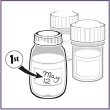
1. Check the date on the stored breast milk. Use the container with the earliest date first.
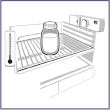
2. Thaw frozen breast milk by leaving it in the refrigerator for 4-24 hours.
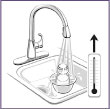
3. Place container under cool water running. Once it has begun to thaw, run warm water to finish thawing.
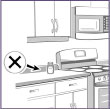
4. Never thaw at room temperature.
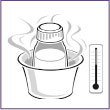
5. Warm breast milk by placing the container in a bowl of very warm water for no more than 15 minutes.
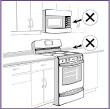
6. Do not thaw or heat breast milk in the microwave. Do not refreeze once it has thawed.
Do not refreeze breast milk once it has started to thaw.
Feeding expressed breast milk (by cup or bottle)
- Shake warmed breast milk well. Check the temperature on your wrist. Let cool if too hot.
- Hold your baby close in an upright position.
- Make feedings an enjoyable time for you and your baby. Talk to your baby and give lots of smiles.
- Watch your baby swallow. Allow baby to rest.
- Burp your baby as needed. Stop feeding when your baby shows signs of being full.
- Throw away what your baby does not drink within 1 hour.
- Do not put your baby to bed with a bottle.
Signs your baby is finished or full
Your baby:
- looks sleepy and calm
- lets go of the nipple
- closes her mouth
- turns away from a cup or bottle
- does not look for more breast milk
- may still have small suckling movement; this is a reflex and does not mean your baby is hungry
If you see signs your baby is full, stop feeding even if the cup or bottle is not empty.
After birth you and your baby will need time to learn to breastfeed. You will also need to look after yourself and your baby. Here are some tips:
- make sleep/rest a priority
- limit visitors, telephone calls and other interruptions during the early weeks
- ask for help when needed; family and friends can help with everyday things like meal preparation, dishes and laundry, keeping the home tidy and caring for other children
- accept help when offered
Breastfeeding and healthy eating
Eating well when breastfeeding helps you to feel your best, recover from labour and birth and get all the nutrients and energy you need. Here are some tips for healthy eating:
- eat balanced meals that include food from at least 3 food groups and snacks that include foods from at least 2 food groups
- eat small meals and snacks every 2-3 hours
- have easy to prepare, healthy snacks available
- prepare meals in large batches; freeze and reheat for a quick meal
- accept help from friends and family who offer you prepared meals
- avoid skipping meals
- drink fluids every time your baby breastfeeds
- carry your water bottle with you
- keep cut-up vegetables and fruit in the fridge and eat them for a quick snack
- take a multivitamin containing folic acid every day
Breastfeeding and medications
In almost all cases it is safe to continue breastfeeding if you need to take medications call your health care provider for more information.
Breastfeeding and contraception (birth control)
Breastfeeding can be used as a method of birth control, but only if you follow these rules:
- Your monthly periods have not returned.
- Your baby is fully or nearly fully breastfed.
- fully breastfed means your baby gets all food from suckling at the breast
- nearly fully breastfed means, in addition to breastfeeding, vitamins, minerals, juice, water or any other foods are given infrequently (no more that 1 or 2 mouthfuls a day)
- to be fully breastfed or nearly fully breastfed, your baby should be breastfed at least every 4 hours and not have more than one 6 hour stretch between breastfeeding in 24 hours
- Your baby is under 6 months.
Other methods of birth control that do not affect breastfeeding include:
- condoms (male and female)
- spermicides
- diaphragm – must be refitted after pregnancy
- I.U.D (Intra-Uterine Device)
- vasectomy
- tubal ligation
Speak to your health care provider for more information about birth control.
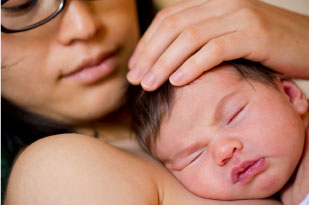
All mothers have the right to breastfeed their babies in public anywhere, anytime.
According to the Ontario Human Rights Commission policy, no one should stop a mother from breastfeeding her child, ask her to cover up or move her to another place.
Tips for breastfeeding in public
- Get comfortable with breastfeeding your baby at home with your family and friends before you breastfeed in public.
- Wear comfortable clothes, a loose fitting top, or breastfeeding top. Use a blanket if you want to cover up.
- Just do it!
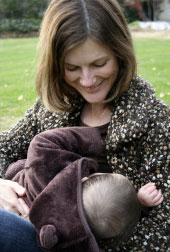
What can I do if someone asks me to stop breastfeeding in public?
- Do what you need to do so that you can breastfeed your child comfortably.
- Talk to the owner, manager, or the individual who asked you to stop breastfeeding.
Tell the person:- It is your right to breastfeed in public.
- You will make a complaint to the Human Rights Tribunal of Ontario if you are asked again to leave, move or cover up.
- Follow up with a letter to the owner or manager. Explain what happened and inform the person that it is your right to breastfeeding in public.
- Follow up with the Ontario Human Rights Tribunal of Ontario at www.hrto.ca or 1-866-598-0322.
How do I make a complaint?
You can make a complaint with the Ontario Human Rights Tribunal of Ontario. Application forms for making a complaint are available at www.hrto.ca.
You may also talk to the Human Rights Legal Support Centre for advice or assistance at www.hrlsc.on.ca or call 1-866-625-5179 to speak with a Human Rights Advisor.
Breastfeeding after the first 6 months
As your baby grows, you may experience changes in how often and long your baby breastfeeds.
Your breast milk will change based on your growing baby’s needs.
You have given your baby the best possible start by breastfeeding for the first 6 months. Breast milk is still the most important food during the first year of your baby’s life. You may want to continue to breastfeed your baby for 2 years or longer. There is no right time to stop. Extra iron is needed at 6 months and it is time to add solid foods.
Why breastfeed your older baby or child?
- Breast milk changes as your baby grows to meet your baby’s changing nutritional needs.
- Breastfeeding is more than food; it’s also about your relationship with your baby.
- When your child is sick, breastfeeding can provide comfort and is a very important source of fluid and food. Breast milk is easy to digest. It may be all your child wants.
- Breast milk protects your child against infection. It strengthens your child’s immunity.
Breast changes
Don’t worry if your breasts feel soft; they will still make enough breast milk. An older child takes breast milk faster than a newborn.
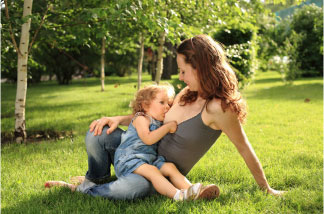
Developmental changes
An older baby becomes more interested in the world around them and can get distracted easily.
A quiet place with less distraction may keep her attention on breastfeeding.
Teething
It is okay to breastfeed even when your child is getting teeth.
- Your baby’s gum may be sore. Offer your baby a cold, clean cloth or teething ring to chew on before breastfeeding.
- If your baby bites, stay calm. Say “No” and take baby off the breast.
- Your baby may bite near the end of the breastfeeding. Watch for sucking changes at the end of the breastfeeding as your baby will have fewer swallows. To end the breastfeeding, pull your baby close and she will open her mouth and pull off easily.
Nursing strikes
Sometimes a baby who has been breastfeeding well suddenly refuses to breastfeed. This is not the same
as natural weaning.
To help your baby return to your breast:
- Talk gently to her and give her more eye-to-eye contact.
- Breastfeed your baby in a quiet, familiar place.
- Breastfeed your baby when she is relaxed and not completely awake.
- Relax. Be patient. Babies usually start to breastfeed again in a few days.
If your breasts are getting too full, you can express some breast milk for comfort. You can offer some expressed breast milk from a cup.

When you and your baby are together, you can breastfeed as much as you like. Breastfeeding your baby when you arrive home from work or school is a great way to bond.
Returning to work or school
If you plan to continue breastfeeding when you return to work or school, you can express or pump your breast milk. Your breasts will continue to produce enough breast milk as long as you breastfeed, express or pump often. Any amount of breast milk is good for your baby.
Tips on breastfeeding and returning to work or school
- Discuss your plans with your employer. The Ontario Human Rights Commission states that employers are required to accommodate women
who are breastfeeding. - Practice expressing or pumping your breast milk before returning to work or school.
- Choose a caregiver who shares your beliefs about breastfeeding.
- Depending on your workplace or school, you may need to find a quiet place to express your breast milk or breastfeed your baby.
- Talk to other women who have combined work and breastfeeding.
- Expressed or pumped breast milk may be given to your baby in a small cup or sippy cup when you are away from home. Begin to store breast milk before returning to work or school.
- The number of times you will need to pump or express breast milk while you are away from home will depend on the length of time you are away.
- Clothes with patterns will help to hide leaks.
- Changes in breast milk supply are normal from day to day so don’t worry about this.
- Pumping both breasts at the same time can help to decrease your pumping time.
- Expressed breast milk may be stored in a refrigerator or a cooler bag with ice packs.
Breastfeeding when you are pregnant
You can breastfeed when you are pregnant.
- your nipples may feel more tender
- you may make less breast milk
- your breast milk may have a different taste
- most children happily continue to breastfeed
Remember to:
- eat variety of foods
- drink when you are thirsty

You can breastfeed an older child and a new baby, either together or at different times.
- Questions: When should I take my baby for a check-up after leaving the hospital?
Answer: Your baby should be seen by a nurse, midwife, lactation consultant, or doctor 3-5 days after leaving the hospital. Your baby should then have a second check-up within 7 days after birth.
This second check-up should be with your doctor. - Question: How long should I breastfeed?
Answer: The Windsor-Essex County Health Unit and the World Health Organization recommend giving only breast milk for the first 6 months. There is no “right time” to stop breastfeeding. After 6 months breastfeeding should be continued for 2 years or more and babies should be given other foods. - Question: Is it safe to breastfeed if I am sick?
Answer: In almost all cases it is safe to continue breastfeeding. If you are sick call your primary health care provider. - Question: How can I calm my crying baby?
Answer: Your baby cries for many reasons; for example food, comfort, warmth or to be held. Babies cry an average of 2-21/2 hours a day. Crying peaks at 2 months and gradually decreases by the fourth to fifth month. Your baby may cry for long periods for no reason. Try to calm your
baby by:- breastfeeding your baby
- holding your baby skin-to-skin
- cuddling or rocking your baby
- carrying your baby in a carrier
- wrapping your baby loosely in a blanket
- burping your baby
- changing your baby’s diaper
- giving your baby a bath
- giving your baby a massage
- taking your baby to a quiet room
- Question: What is mother to mother support?
Answer: Support from other mothers who are also breastfeeding can be helpful. This includes friends and relatives. You can also meet breastfeeding mothers through La Leche League, parenting groups or for information about breastfeeding supports in the community, call the
Windsor-Essex County Health Unit Family Health Hotline at 519-258-2146, ext. 1350, or go to the “Where to get help” page, on the inside front cover of this book.

